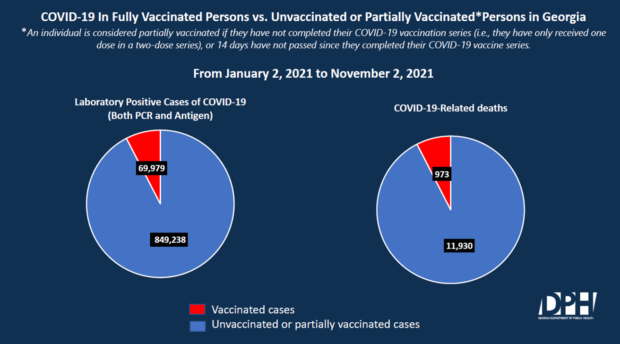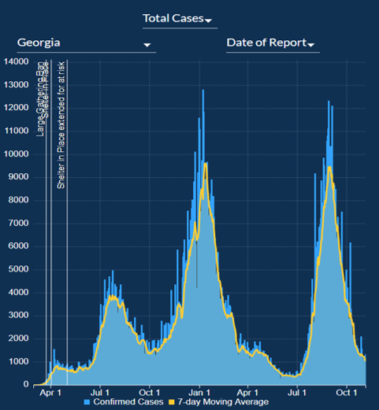
Caption
Georgia Public Health officials are encouraging businesses to offer incentives for workers to get vaccinated.
Credit: Georgia Department of Public Health

Georgia Public Health officials are encouraging businesses to offer incentives for workers to get vaccinated.
The recent news on COVID in Georgia appears quite good — cases, hospitalizations and deaths have all dropped to a low plateau, state health officials said Tuesday.
But the number of vaccinations has also shown a recent decline, with the rate of Georgia residents fully vaccinated now hovering at about 50%. During October, vaccinations dropped 30% to 40%.
That could change since recent approval of the Pfizer vaccine for children ages 5 to 11.
Yet Cherie Drenzek, the state epidemiologist, told the Georgia Department of Public Health’s board that she remains cautious about what lies ahead. “This virus does nothing but surprise us,’’ she said.
Nearly all the recent hospitalizations and deaths have occurred in unvaccinated individuals, she said.
The virus is surging in some states in the West, and also in Europe, Drenzek said. California, New Mexico and Colorado, along with some Northern states, have seen case numbers rise over the past two weeks, according to data in the New York Times.
New cases in the Southeast remain very low, she said.

“Our vaccination rate in Georgia remains among the worst in the nation, which means that if there is another Delta surge over the holidays, there are still many vulnerable Georgians, especially in rural parts of the state,’’ DR. Harry Heiman said.
In Georgia, just 8% of counties have high transmission rates, Drenzek said. They include Chattahoochee County, which is home to a large part of the Army’s Fort Benning, and Bacon County in Southeast Georgia.
Dr. Harry Heiman, a public health expert at Georgia State University, said Tuesday that there are positive and encouraging trends on COVID in the state, “but we are far from out of the woods.’’
“Our vaccination rate in Georgia remains among the worst in the nation, which means that if there is another delta surge over the holidays, there are still many vulnerable Georgians, especially in rural parts of the state,’’ Heiman said.
“Now is a time to remain vigilant, work even harder to increase vaccination rates, including among newly eligible children, and not back away from evidence-based practices like indoor mask mandates . . . or do away with mask mandates in schools,’’ he added.
Georgia Public Health officials are encouraging businesses to offer incentives for workers to get vaccinated.
Gov. Brian Kemp, who has also promoted vaccinations in Georgia, nevertheless joined state Attorney General Chris Carr, along with Alabama and Florida officials, in filing a lawsuit Friday to challenge a federal order requiring companies with 100 or more employees to impose mandatory COVID vaccinations of their workers or weekly testing by Jan. 4.
A similar legal challenge from Louisiana officials moved a federal appeals court Saturday to suspend the new vaccine mandate while judges can review the law.
On a national level, the Institute for Health Metrics and Evaluation (IHME) at the University of Washington is projecting a moderate surge in COVID cases this winter.
IHME modeler Christopher J.L. Murray said last Thursday that reductions in cases, estimated infections, and hospitalizations have essentially stopped in the United States, and we are starting to turn toward another rise in infections.
Rising COVID-19 numbers here in the northern hemisphere are due, in part, to the fact that winter temperatures are coming, Murray said.
Vaccine-derived immunity against COVID wanes considerably over the six-month period after vaccination, he said.
Another factor, Murray added, is that “people are much less cautious than last winter, as mask use is much lower. Currently, it is below 40% in the U.S. — slightly higher than that in Europe, but much lower than a year ago.’’
This story comes to GPB through a reporting partnership with Georgia Health News.